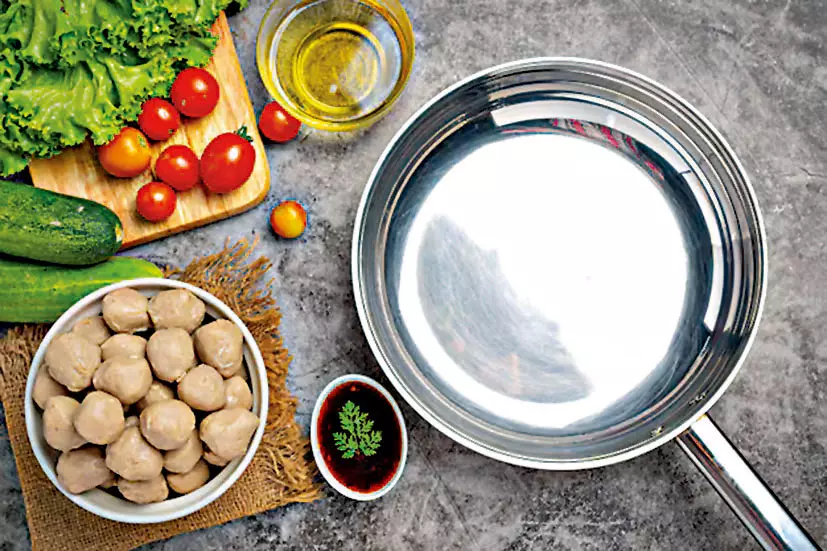Deadly Morsels of 'Non-Sticky' food
Worn-out non-stick utensils release Perfluorooctanoic acid (PFOA) and polytetrafluoroethylene (PTFE) that could pose serious health risks—kidney problems, breast cancer, reduced fertility and liver tumors

Non-stick pots and pans are a staple in many Indian kitchens. But some studies suggest that a single innocent scratch on the non-stick surface can release millions of microplastics into your food. Sounds dramatic? Maybe. But science is serious. Non-stick cookware often contains polytetrafluoroethylene (PTFE), commonly known as Teflon, which gives it a smooth surface. When scratched, tiny plastic particles break free and ride straight into your meal. You won't be able to taste them, and most definitely won’t be able to see them. But once inside your body, they can cause some damage, even if it’s a micro one. “Scratched non-stick pans release harmful toxins like Perfluo-rooctanoic acid (PFOA) and polytetrafluoroethylene (PTFE), which can contaminate your food,” says Dr. Aarti Ullal, a physician and diabetologist at Gleneagles Hospital Parel.
Some studies add that microplastics may contribute to hormone disruption, neurological issues, cancer, and infertility. Some studies explore the possibilities of links to conditions like autism… and while the long-term effects are still under investigation, there is no harm in swapping those pans for something much safer. Short-term exposure can lead to symptoms like respiratory irritation, coughing, chest tightness, and even what’s known as 'Teflon flu.' “Long-term exposure may increase the risk of cancer, hormonal disruption, liver damage, and reproductive issues,” warns Dr. S. Karthikeyan, Senior Consultant in Critical Care Medicine & Toxicology at Meenak-shi Super Specialty Hospital, Madurai. “Symptoms of exposure can include fatigue, thyroid problems, unexplained weight gain, and fertility challenges. If your pan is visibly damaged, it’s time to replace it,” adds Dr Ullal.
Scripty Scrap Crap
Non-stick pans aren’t invincible, they do have their enemies such as Metal spatulas, metal clean-ing pads or even scraping the surface of the pan while cooking all these small imperfections add up. Unlike a broken mug or chipped plate, a scratch non-stick pan keeps its secrets– until you realize that the leftover masala on the pan just refuses to get off!
The irony? Most people hang onto their damaged non-stick pans because they technically ‘work.’ However, function and safety are two very different things; that slightly worn-out skillet may be slipping into family dinners, and no amount of extra seasoning will help make it right. Adding further insights, Dr. S. Karthikeyan explains, “When a non-stick pan is scratched, the PTFE coat is damaged, exposing the underlying metal. If the pan is heated above 500°F (260°C), toxic fumes and harmful chemicals like PFOA and PFAS can be released.”
Knowing when to part ways with a non-stick pan is key to having a healthy relationship with yourself. Visible scratches, peeling edges, discoloration, or a roughened texture are all red flags. If food is sticking to the pan despite the label promising a flawless non-stick experience, the coating may be compromised; the ‘if in doubt, throw it out’ mantra applies here.
Hidden in Plain Sight
But before you rush to throw out the trash, it’s always best to check with your local recycling center. If someone accepts non-stick cookware, many companies offer recycling programs that repurpose the materials into new products. It’s a small step that makes a big impact.
Although there is a silver lining, plenty of safer cookware options are built to last — and won't sprinkle microplastics all over your food.
Stainless steel, cast iron, ceramic coated and carbon steel develop a natural non-stick surface with use and are a favourite in high end restaurants for a good reason! They are virtually indestructible, a well-seasoned cast, free from harmful chemicals and a sleeker surface which requires a little bit more oil to prevent sticking…. A little olive oil won’t hurt much!
Better Pan Plans
The best buy in India, the Vinod Stainless Steel Cookware Set costs around `3,000 to `4,500, while the Indus Valley Cast Iron Set is priced at `2,399. The Caraway Ceramic Cookware Set can range from `30,000 to `35,000 with import fees, and the Misen Carbon-Steel Frying Pan typically costs `5,000 to `7,000. Ceramic-coated cookware is often free from PTFE, it's light and easy to clean. Better yet, it's more gentle on the environment. If you’re not yet ready to give up the nonstick, you can just extend the life of your pans by using silicone or wooden utensils to avoid the high heat. Although you must be warned, PTFE is not a fan of high temperatures.
When storing your pans, the best way to do it is by layering them with a cloth or a pan protector to prevent further scratches and with a little effort your pan can stay in a pristine condition for years. “Stainless steel pans are a staple in my kitchen. After a while, using non-stick pans became frustrating — I had to constantly check for black flakes chipping off into my food,” says homemaker Bhairavi Tripathi.
Swapping out a scratched pan for a stainless-steel pan can weigh a bit on the price tag, but consider it an investment in your health. Reducing your exposure to microplastics isn’t about paranoia — it’s about making small, proactive choices that add up over time.
Plus, upgrading your cookware is a great excuse to finally perfect that cast iron skillet chicken; the next time you spot a scratch on a nonstick pan, see it for what it is… a sign to throw it out. And invite in a new book of recipes and a healthier, happier kitchen. Your future self — and your taste buds — will thank you.

